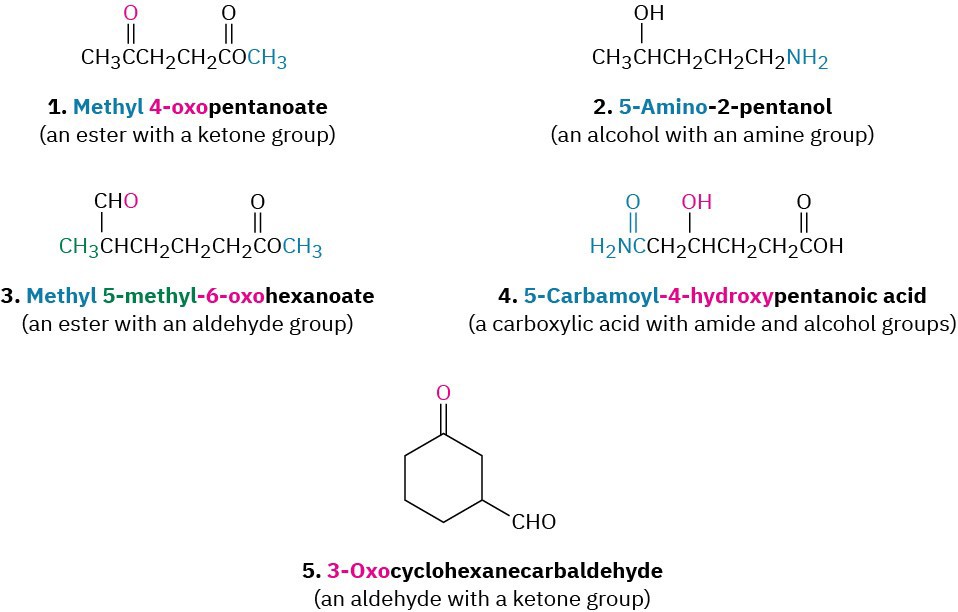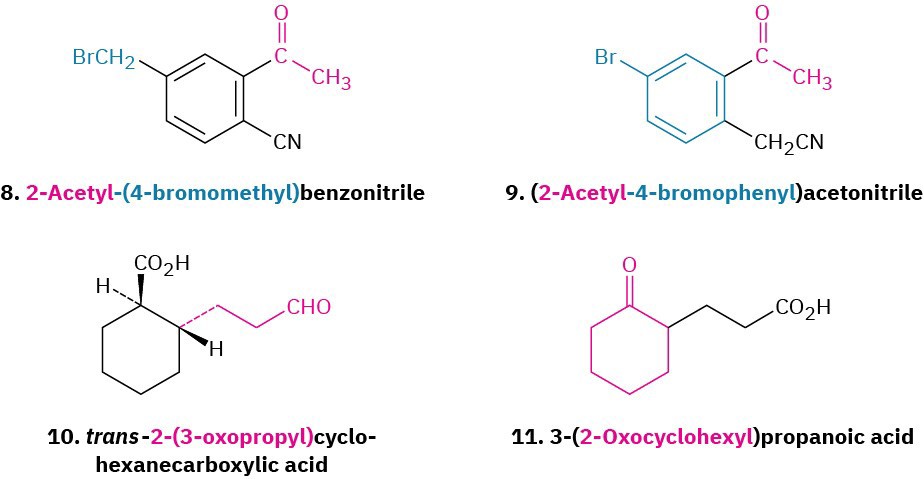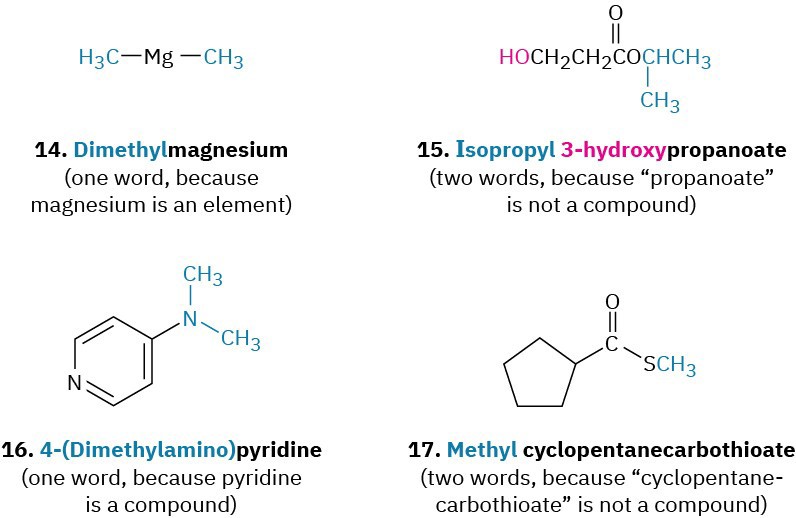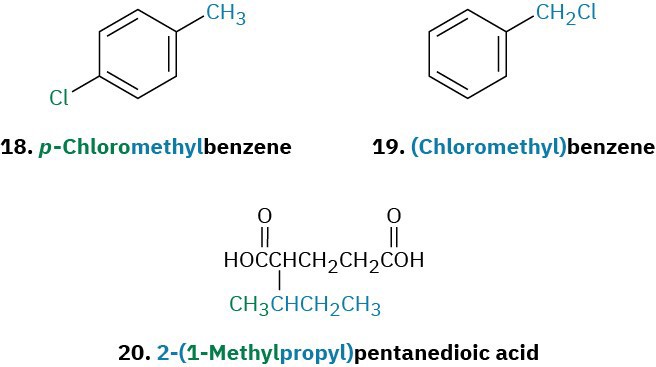Appendix A | Nomenclature of Polyfunctional Organic Compounds
Appendix A | Nomenclature of Polyfunctional Organic Compounds
With more than 40 million organic compounds now known and thousands more being created daily, naming them all is a real problem. Part of the problem is due to the sheer complexity of organic structures, but part is also due to the fact that chemical names have more than one purpose. For the Chemical Abstracts Service (CAS), which catalogs and indexes the worldwide chemical literature, each compound must have only one correct name. It would be chaos if half the entries for CH3Br were indexed under “M” for methyl bromide and half under “B” for bromomethane. Furthermore, a CAS name must be strictly systematic so that it can be assigned and interpreted by computers; common names are not allowed.
People, however, have different requirements than computers. For people—which is to say students and professional chemists in their spoken and written communications—it’s best that a chemical name be pronounceable and as easy as possible to assign and interpret.
Furthermore, it’s convenient if names follow historical precedents, even if that means a particularly well-known compound might have more than one name. People can readily understand that bromomethane and methyl bromide both refer to CH3Br.
As noted in the text, chemists overwhelmingly use the nomenclature system devised and maintained by the International Union of Pure and Applied Chemistry, or IUPAC. Rules for naming monofunctional compounds were given throughout the text as each new functional group was introduced, and a list of where these rules can be found is given in Table A1.
Table A1 Nomenclature Rules for Functional Groups
| Functional group | Text section |
| Acid anhydrides | 11-1 |
| Acid halides | 11-1 |
| Acyl phosphates | 11-1 |
| Alcohols | 10-1 |
| Aldehydes | 10-1 |
| Alkanes | 2-4 |
| Alkenes | 4-1 |
| Alkyl halides | 6-1 |
| Alkynes | 4-1 |
| Amides | 11-1 |
| Amines | 12-1 |
| Functional group | Text section |
| Aromatic compounds | 8-2 |
| Carboxylic acids | 11-1 |
| Cycloalkanes | 2-5 |
| Esters | 11-1 |
| Ethers | 9-3 |
| Ketones | 10-1 |
| Nitriles | 11-1 |
| Phenols | 9-1 |
| Sulfides | 9-15 |
| Thiols | 9-15 |
| Thioesters | 11-1 |
Naming a monofunctional compound is reasonably straightforward, but even experienced chemists often encounter problems when faced with naming a complex polyfunctional compound. Take the following compound, for instance. It has three functional groups, ester, ketone, and C═C, but how should it be named? As an ester with an –oate ending, a ketone with an –one ending, or an alkene with an –ene ending? It’s actually named methyl 3-(2-oxo-6-cyclohexenyl)propanoate.

The name of a polyfunctional organic molecule has four parts—suffix, parent, prefixes, and locants—which must be identified and expressed in the proper order and format. Let’s look at each of the four.
Name Part 1. The Suffix: Functional-Group Precedence
Although a polyfunctional organic molecule might contain several different functional groups, we must choose just one suffix for nomenclature purposes. It’s not correct to use two suffixes. Thus, keto ester 1 must be named either as a ketone with an –one suffix or as an ester with an –oate suffix, but it can’t be named as an –onoate. Similarly, amino alcohol 2 must be named either as an alcohol (-ol) or as an amine (-amine), but it can’t be named as an –olamine or –aminol.

The only exception to the rule requiring a single suffix is when naming compounds that have double or triple bonds. Thus, the unsaturated acid H!C═CHCH!CO!H is 3-butenoic acid, and the acetylenic alcohol HC≡CCH!CH!CH!OH is 5-pentyn-1-ol.
How do we choose which suffix to use? Functional groups are divided into two classes, principal groups and subordinate groups, as shown in Table A2. Principal groups can be cited either as prefixes or as suffixes, while subordinate groups are cited only as prefixes. Within the principal groups, an order of priority has been established: the proper suffix for a given compound is determined by choosing the principal group of highest priority. For example, Table A2 indicates that keto ester 1 should be named as an ester rather than as a ketone because an ester functional group is higher in priority than a ketone. Similarly, amino alcohol 2 should be named as an alcohol rather than as an amine. Thus, the name for 1 is methyl 4-oxopentanoate and the name for 2 is 5-amino-2-pentanol. Further examples are shown:
Table A2 Classification of Functional Groups
| Functional group | Name as suffix | Name as prefix |
| Principal groups | ||
| Carboxylic acids | -oic acid | carboxy |
| -carboxylic acid | ||
| Acid anhydrides | -oic anhydride | — |
| -carboxylic anhydride | ||
| Esters | -oate | alkoxycarbonyl |
| -carboxylate | ||
| Thioesters | -thioate | alkylthiocarbonyl |
| -carbothioate | ||
| Acid halides | -oyl halide | halocarbonyl |
| -carbonyl halide | ||
| Amides | -amide | carbamoyl |
| -carboxamide | ||
| Nitriles | -nitrile | cyano |
| -carbonitrile | ||
| Aldehydes | -al | oxo |
| -carbaldehyde | ||
| Ketones | -one | oxo |
| Alcohols | -ol | hydroxy |
| Phenols | -ol | hydroxy |
| Thiols | -thiol | mercapto |
| Amines |
-amine
|
amino |
| Imines | -imine | imino |
| Ethers | ether | alkoxy |
| Sulfides | sulfide | alkylthio |
| Functional group | Name as suffix | Name as prefix |
| Disulfides | disulfide | — |
| Alkenes | -ene | — |
| Alkynes | -yne | — |
| Alkanes | -ane | — |
| Subordinate groups | ||
| Azides | — | azido |
| Halides | — | halo |
| Nitro compounds | — | nitro |
| Principal groups are listed in order of decreasing priority; subordinate groups have no priority order. | ||

Name Part 2. The Parent: Selecting the Main Chain or Ring
The parent, or base, name of a polyfunctional organic compound is usually easy to identify. If the principal group of highest priority is part of an open chain, the parent name is that of the longest chain containing the largest number of principal groups. For example, compounds 6 and 7 are isomeric aldehydo amides, which must be named as amides rather than as aldehydes according to Table A2. The longest chain in compound 6 has six carbons, and the substance is named 5-methyl-6-oxohexanamide. Compound 7 also has a chain of six carbons, but the longest chain that contains both principal functional groups has only four carbons. Thus, compound 7 is named 4-oxo-3-propylbutanamide.
 If the highest-priority principal group is attached to a ring, the parent name is that of the ring system. Compounds 8 and 9, for instance, are isomeric keto nitriles and must both be named as nitriles according to Table A2. Substance 8 is named as a benzonitrile because the −CN functional group is a substituent on the aromatic ring, but substance 9 is named as an acetonitrile because the −CN functional group is on an open chain. Thus, their names are 2-acetyl-(4-bromomethyl)benzonitrile (8) and (2-acetyl-4-bromophenyl)acetonitrile (9).
If the highest-priority principal group is attached to a ring, the parent name is that of the ring system. Compounds 8 and 9, for instance, are isomeric keto nitriles and must both be named as nitriles according to Table A2. Substance 8 is named as a benzonitrile because the −CN functional group is a substituent on the aromatic ring, but substance 9 is named as an acetonitrile because the −CN functional group is on an open chain. Thus, their names are 2-acetyl-(4-bromomethyl)benzonitrile (8) and (2-acetyl-4-bromophenyl)acetonitrile (9).
As further examples, compounds 10 and 11 are both keto acids and must be named as acids, but the parent name in 10 is that of a ring system (cyclohexanecarboxylic acid) and the parent name in 11 is that of an open chain (propanoic acid). Thus, their names are trans-2-(3-oxopropyl)cyclohexanecarboxylic acid (10) and 3-(2-oxocyclohexyl)propanoic acid (11).

Name Parts 3 and 4. The Prefixes and Locants
With the parent name and the suffix established, the next step is to identify and give numbers, or locants, to all substituents on the parent chain or ring. The substituents include all alkyl groups and all functional groups other than the one cited in the suffix. For example, compound 12 contains three different functional groups (carboxyl, keto, and double bond). Because the carboxyl group is highest in priority and the longest chain containing the functional groups has seven carbons, compound 12 is a heptenoic acid. In addition, the parent chain has a keto (oxo) substituent and three methyl groups.
Numbering from the end nearer the highest-priority functional group gives the name (E)- 2,5,5-trimethyl-4-oxo-2-heptenoic acid. Look back at some of the other compounds we’ve named to see other examples of how prefixes and locants are assigned.
Writing the Name
With the name parts established, the entire name can be written out. Several additional rules apply:
-
Order of prefixes. When the substituents have been identified, the parent chain has been numbered, and the proper multipliers such as di– and tri– have been assigned, the name is written with the substituents listed in alphabetical, rather than numerical, order. Multipliers such as di– and tri– are not used for alphabetization, but the italicized prefixes iso– and sec– are used.

-
Use of hyphens; single- and multiple-word names. The general rule is to determine whether the parent is itself an element or compound. If it is, then the name is written as a single word; if it isn’t, then the name is written as multiple words. Methylbenzene is written as one word, for instance, because the parent— benzene—is a compound. Diethyl ether, however, is written as two words because the parent—ether—is a class name rather than a compound name. Some further examples follow:

-
Parentheses. Parentheses are used to denote complex substituents when ambiguity would otherwise arise. For example, chloromethylbenzene has two substituents on a benzene ring, but (chloromethyl)benzene has only one complex substituent. Note that the expression in parentheses is not set off by hyphens from the rest of the name.
Additional Reading
Further explanations of the rules of organic nomenclature can be found online at ACD Labs (accessed May 2023) and in the following references:
-
“A Guide to IUPAC Nomenclature of Organic Compounds,” CRC Press, Boca Raton, FL, 1993.
- “Nomenclature of Organic Chemistry, Sections A, B, C, D, E, F, and H,” International Union of Pure and Applied Chemistry, Pergamon Press, Oxford, 1979.



